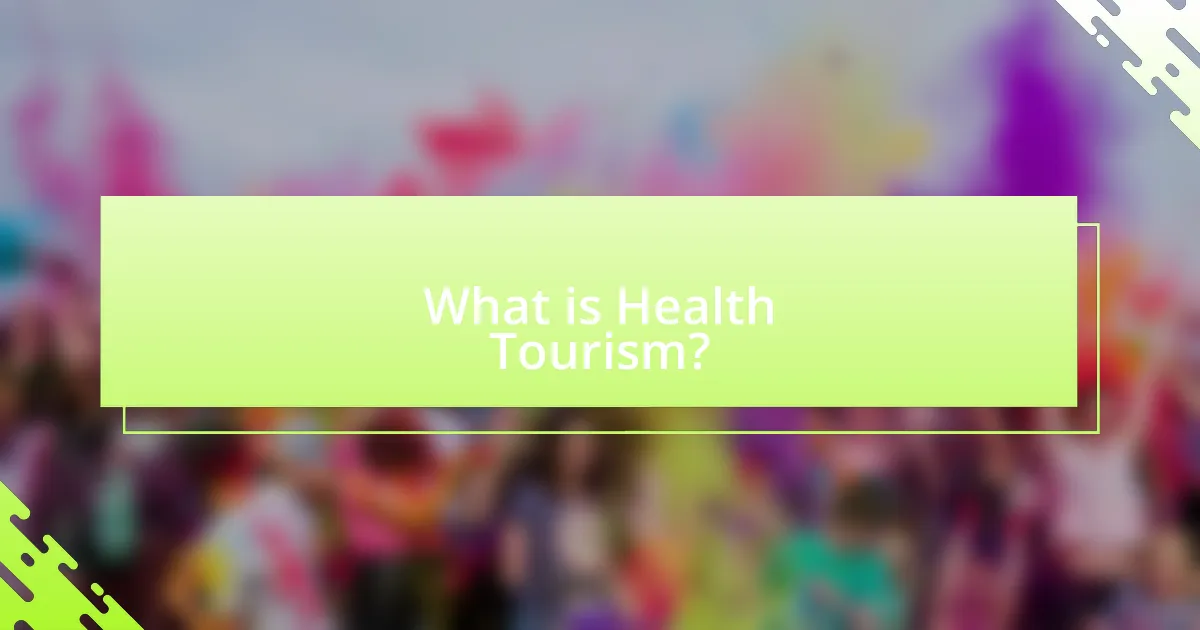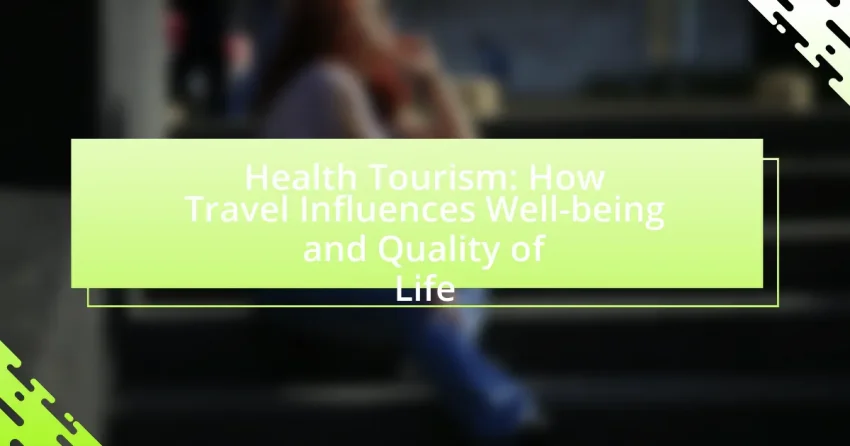Health tourism is the practice of traveling to another country or region to receive medical treatment or health-related services, driven by factors such as cost savings and access to advanced technologies. This article explores the distinctions between health tourism and traditional tourism, highlighting key components such as medical services, wellness services, and patient support. It examines the motivations behind health tourism, the various types including medical and wellness tourism, and the psychological and physical benefits associated with travel. Additionally, the article addresses the challenges and risks involved in health tourism, offering best practices for ensuring a positive experience while emphasizing the importance of thorough research and preparation.

What is Health Tourism?
Health tourism refers to the practice of traveling to another country or region to receive medical treatment or health-related services. This phenomenon has gained popularity due to factors such as lower costs, access to advanced medical technologies, and the opportunity for patients to combine treatment with leisure activities. According to a report by the Medical Tourism Association, the global health tourism market was valued at approximately $54 billion in 2017 and is projected to grow significantly, highlighting its increasing relevance in the healthcare landscape.
How does Health Tourism differ from traditional tourism?
Health tourism differs from traditional tourism primarily in its focus on health-related services and treatments rather than leisure or recreational activities. While traditional tourism emphasizes experiences such as sightseeing, cultural immersion, and relaxation, health tourism centers on medical procedures, wellness therapies, and health improvement. According to the Global Wellness Institute, the health tourism market was valued at approximately $639 billion in 2017, highlighting its significant economic impact compared to traditional tourism, which primarily generates revenue through hospitality and entertainment sectors. This distinction underscores the unique motivations and outcomes associated with health tourism, as individuals seek to enhance their physical and mental well-being through travel.
What are the key components of Health Tourism?
The key components of Health Tourism include medical services, wellness services, travel logistics, and patient support. Medical services encompass procedures such as surgeries, dental care, and specialized treatments, often provided at accredited facilities. Wellness services focus on holistic approaches, including spa treatments, yoga, and alternative therapies aimed at improving overall well-being. Travel logistics involve the planning and coordination of transportation, accommodation, and local arrangements to facilitate the patient’s journey. Patient support includes pre- and post-treatment care, language assistance, and cultural orientation to enhance the overall experience and ensure safety and comfort during the health tourism journey.
How do motivations for Health Tourism vary among travelers?
Motivations for health tourism vary significantly among travelers, influenced by factors such as personal health needs, cost considerations, and the desire for specific treatments. For instance, some travelers seek health tourism for affordable medical procedures, as countries like India and Thailand offer high-quality care at lower prices compared to Western nations. Others may be motivated by the availability of specialized treatments not accessible in their home countries, such as advanced cosmetic surgery or alternative therapies. Additionally, wellness tourism attracts individuals looking for holistic health experiences, including spa treatments and wellness retreats, which emphasize relaxation and mental well-being. According to a report by the Medical Tourism Association, over 14 million Americans traveled abroad for medical care in 2017, highlighting the diverse motivations behind health tourism.
What are the main types of Health Tourism?
The main types of health tourism are medical tourism, wellness tourism, and alternative tourism. Medical tourism involves traveling to receive medical treatments, often at lower costs or with shorter wait times than in the patient’s home country. Wellness tourism focuses on improving health and well-being through activities such as spa treatments, yoga retreats, and holistic therapies. Alternative tourism encompasses travel for non-conventional medical treatments, including traditional medicine practices and therapies not widely available in the patient’s home country. These categories reflect the diverse motivations and services associated with health tourism, which has grown significantly, with the global medical tourism market projected to reach $179.6 billion by 2026, according to a report by Research and Markets.
What is medical tourism and how does it function?
Medical tourism is the practice of traveling to another country to receive medical treatment, often due to lower costs, higher quality care, or access to procedures not available in one’s home country. It functions by allowing patients to seek healthcare services abroad, where they can combine medical care with travel experiences. The global medical tourism market was valued at approximately $44.8 billion in 2020 and is projected to grow significantly, driven by factors such as rising healthcare costs in developed countries and advancements in medical technology in emerging markets.
How does wellness tourism contribute to overall well-being?
Wellness tourism contributes to overall well-being by promoting physical, mental, and emotional health through activities focused on relaxation, rejuvenation, and self-care. Engaging in wellness tourism often includes practices such as yoga, meditation, and spa treatments, which have been shown to reduce stress and improve mental clarity. Research indicates that participants in wellness tourism report higher levels of life satisfaction and lower levels of anxiety, as evidenced by a study published in the Journal of Travel Research, which found that wellness travelers experience significant improvements in psychological well-being compared to non-wellness travelers.
What are the benefits of Health Tourism for individuals?
Health tourism offers individuals access to high-quality medical care at lower costs, often in destinations with advanced healthcare facilities. This allows patients to receive treatments that may be prohibitively expensive or unavailable in their home countries. For example, a study by Patients Beyond Borders indicates that individuals can save up to 70% on procedures like dental work or cosmetic surgery when traveling abroad. Additionally, health tourism provides the opportunity for a holistic experience, combining medical treatment with relaxation and recovery in a new environment, which can enhance overall well-being and satisfaction.
How does Health Tourism impact physical health?
Health tourism positively impacts physical health by providing access to medical treatments and wellness services that may be unavailable or unaffordable in a person’s home country. This type of tourism often includes procedures such as surgeries, dental care, and alternative therapies, which can lead to improved health outcomes. For instance, a study published in the Journal of Travel Medicine found that patients who traveled for medical procedures reported higher satisfaction and better recovery rates compared to those who received care locally. Additionally, health tourism can promote preventive care and wellness practices, contributing to overall physical well-being.
What psychological benefits can be gained from Health Tourism?
Health tourism can provide significant psychological benefits, including reduced stress, improved mental well-being, and enhanced life satisfaction. Engaging in health tourism allows individuals to escape their daily routines, which can alleviate stress and anxiety. Research indicates that travel can lead to increased happiness and a sense of rejuvenation, as individuals experience new environments and cultures. Additionally, the focus on health and wellness during these trips can foster a positive mindset, encouraging individuals to adopt healthier lifestyles upon their return. Studies have shown that exposure to nature and new experiences during travel can enhance mood and promote psychological resilience, further supporting the mental health benefits associated with health tourism.

How does Travel Influence Well-being?
Travel positively influences well-being by enhancing mental health, reducing stress, and promoting social connections. Engaging in travel allows individuals to experience new environments, which can lead to increased happiness and life satisfaction. Research indicates that travel can lower levels of anxiety and depression; for instance, a study published in the Journal of Travel Research found that vacations can significantly improve mood and overall mental health. Additionally, travel fosters social interactions, which are crucial for emotional support and well-being, as highlighted by the World Health Organization’s emphasis on social determinants of health.
What role does travel play in enhancing mental health?
Travel plays a significant role in enhancing mental health by providing opportunities for relaxation, new experiences, and social interaction. Engaging in travel can reduce stress levels, as studies indicate that taking vacations can lower cortisol, the stress hormone, and improve overall mood. For instance, a study published in the Journal of Happiness Studies found that individuals who travel frequently report higher levels of happiness and life satisfaction compared to those who do not travel. Additionally, exposure to new environments and cultures can stimulate cognitive flexibility and creativity, further contributing to improved mental well-being.
How does exposure to new environments affect stress levels?
Exposure to new environments generally reduces stress levels. This reduction occurs due to the novelty and stimulation provided by unfamiliar surroundings, which can distract individuals from daily stressors and promote relaxation. Research indicates that engaging with new environments can activate the brain’s reward system, leading to increased feelings of happiness and decreased anxiety. For instance, a study published in the Journal of Environmental Psychology found that individuals who traveled to new locations reported lower stress levels and improved mood compared to those who remained in familiar settings.
What are the long-term effects of travel on mental well-being?
Travel has significant long-term effects on mental well-being, including enhanced emotional resilience, reduced stress levels, and improved overall life satisfaction. Engaging in travel exposes individuals to new experiences and cultures, which can foster personal growth and adaptability. Research indicates that individuals who travel frequently report higher levels of happiness and lower levels of depression, as travel often leads to the formation of lasting memories and social connections. A study published in the Journal of Travel Research found that travel can contribute to a greater sense of purpose and fulfillment in life, reinforcing the positive impact of travel on mental health over time.
How can travel improve physical health outcomes?
Travel can improve physical health outcomes by promoting increased physical activity and reducing stress levels. Engaging in activities such as walking, hiking, or exploring new environments during travel encourages movement, which can enhance cardiovascular health and overall fitness. A study published in the Journal of Travel Research found that travelers often engage in more physical activities compared to their daily routines, leading to improved health metrics. Additionally, exposure to new cultures and environments can reduce stress, which is linked to various health issues, including hypertension and heart disease. Research from the Global Journal of Health Science indicates that leisure travel significantly lowers stress hormones, contributing to better physical health outcomes.
What types of activities during travel promote physical fitness?
Activities during travel that promote physical fitness include hiking, cycling, swimming, and engaging in local sports. Hiking allows travelers to explore natural landscapes while providing cardiovascular benefits and muscle strengthening. Cycling offers a low-impact workout that enhances endurance and leg strength, often allowing for exploration of urban or rural areas. Swimming is a full-body exercise that improves cardiovascular health and muscle tone, and it can be enjoyed in various settings, such as beaches or pools. Participating in local sports, such as beach volleyball or soccer, not only promotes fitness but also fosters social interaction and cultural immersion. These activities contribute to overall well-being by enhancing physical health and providing opportunities for social engagement during travel.
How does travel contribute to healthier lifestyle choices?
Travel contributes to healthier lifestyle choices by promoting physical activity, encouraging healthier eating habits, and enhancing mental well-being. Engaging in activities such as walking, hiking, or exploring new environments increases physical fitness levels, as studies show that travelers often walk more than they do at home. Additionally, exposure to diverse cuisines can lead to healthier eating patterns, as travelers may opt for fresh, local foods over processed options. Furthermore, travel reduces stress and improves mental health, with research indicating that vacations can lower the risk of heart disease and enhance overall life satisfaction.

What are the challenges associated with Health Tourism?
Health tourism faces several challenges, including regulatory issues, quality of care variability, and cultural differences. Regulatory issues arise from differing healthcare standards and legal frameworks across countries, which can complicate patient safety and accountability. Quality of care variability is a significant concern, as not all facilities meet the same standards, leading to potential risks for patients. Cultural differences can also pose challenges, as patients may encounter language barriers and differing healthcare practices, affecting their overall experience and satisfaction. These challenges can impact the effectiveness and safety of health tourism, making it essential for patients to conduct thorough research before seeking medical care abroad.
What risks should travelers be aware of when engaging in Health Tourism?
Travelers engaging in Health Tourism should be aware of several risks, including inadequate medical standards, potential for medical malpractice, and complications arising from language barriers. Inadequate medical standards can lead to subpar care, as not all countries have the same regulations or quality controls as those in the traveler’s home country. Medical malpractice is a concern, as legal recourse may be limited in foreign jurisdictions, making it difficult for patients to seek justice if something goes wrong. Additionally, language barriers can hinder effective communication between patients and healthcare providers, increasing the risk of misunderstandings regarding treatment plans or medical histories. These risks highlight the importance of thorough research and careful planning before pursuing health-related travel.
How can travelers mitigate potential health risks?
Travelers can mitigate potential health risks by conducting thorough research on their destination’s health conditions and vaccination requirements. This proactive approach allows travelers to understand prevalent diseases and necessary immunizations, reducing the likelihood of illness. For instance, the Centers for Disease Control and Prevention (CDC) recommends specific vaccines for various regions, highlighting the importance of preparation. Additionally, travelers should maintain good hygiene practices, such as frequent handwashing and using hand sanitizers, to prevent the spread of infections. According to the World Health Organization (WHO), these measures significantly lower the risk of communicable diseases during travel.
What are the ethical considerations in Health Tourism?
Ethical considerations in health tourism include patient safety, informed consent, and equitable access to healthcare services. Patient safety is paramount, as travelers may encounter substandard medical practices or facilities that do not meet international standards. Informed consent is crucial, as patients must fully understand the risks and benefits of procedures, especially when receiving care abroad. Equitable access addresses the potential for exploitation of vulnerable populations, ensuring that health tourism does not prioritize profit over patient welfare. These considerations are supported by guidelines from organizations like the World Health Organization, which emphasize the importance of ethical practices in global health initiatives.
How can travelers ensure a positive Health Tourism experience?
Travelers can ensure a positive Health Tourism experience by conducting thorough research on healthcare providers and facilities before making arrangements. This includes verifying the credentials of medical professionals, reading patient reviews, and understanding the quality of care offered at the destination. According to a study published in the Journal of Travel Medicine, 60% of health tourists reported that prior research significantly influenced their satisfaction with the services received. Additionally, travelers should consider factors such as the destination’s healthcare regulations, language barriers, and post-treatment care options to enhance their overall experience.
What factors should be considered when choosing a destination for Health Tourism?
When choosing a destination for Health Tourism, factors such as the quality of healthcare services, cost of treatment, accreditation of medical facilities, availability of specialized treatments, and the destination’s safety and accessibility should be considered. Quality of healthcare services is crucial, as destinations with internationally accredited hospitals, like those accredited by the Joint Commission International, ensure high standards of care. Cost of treatment varies significantly across countries; for instance, medical procedures in countries like India can be up to 80% cheaper than in the United States. The availability of specialized treatments is also important; destinations known for specific procedures, such as Thailand for cosmetic surgery, attract health tourists seeking expertise. Safety and accessibility, including political stability and ease of travel, further influence the decision-making process, as travelers prioritize their well-being and comfort during their health journey.
How can travelers prepare for a Health Tourism journey?
Travelers can prepare for a Health Tourism journey by conducting thorough research on potential destinations, healthcare providers, and treatment options. This preparation involves evaluating the quality of medical facilities, checking the credentials of healthcare professionals, and understanding the legal and ethical standards of the destination country. According to a study published in the Journal of Travel Medicine, 60% of health tourists reported that they chose their destination based on the reputation of healthcare services. Additionally, travelers should ensure they have appropriate travel insurance that covers medical procedures abroad and consult with their primary healthcare provider to discuss any pre-existing conditions or necessary vaccinations.
What are the best practices for engaging in Health Tourism?
The best practices for engaging in Health Tourism include thorough research on healthcare providers, understanding legal and ethical considerations, and ensuring post-treatment care. Engaging in Health Tourism requires patients to investigate the credentials and reviews of medical facilities and practitioners to ensure quality care. Additionally, understanding the legal implications, such as patient rights and medical malpractice laws in the destination country, is crucial for safeguarding one’s interests. Furthermore, planning for post-treatment care is essential, as it ensures continuity of care and recovery, which can significantly impact overall health outcomes. These practices are supported by studies indicating that informed patients experience better health outcomes and satisfaction in their medical journeys.
How can travelers find reputable health service providers abroad?
Travelers can find reputable health service providers abroad by researching accredited medical facilities and checking reviews from previous patients. Utilizing resources such as the International Society for Quality in Health Care, which provides a list of accredited hospitals globally, can ensure that travelers choose facilities that meet international standards. Additionally, platforms like Patients Beyond Borders offer comprehensive guides and patient testimonials, helping travelers make informed decisions based on real experiences.
What tips can enhance the overall Health Tourism experience?
To enhance the overall Health Tourism experience, travelers should prioritize thorough research on healthcare providers and facilities. This ensures that patients select accredited institutions with positive reviews and successful treatment outcomes. For instance, the Joint Commission International (JCI) accreditation signifies that a hospital meets international healthcare quality standards, which can significantly impact patient safety and satisfaction. Additionally, engaging with local health tourism agencies can provide valuable insights and support throughout the journey, further improving the experience.
